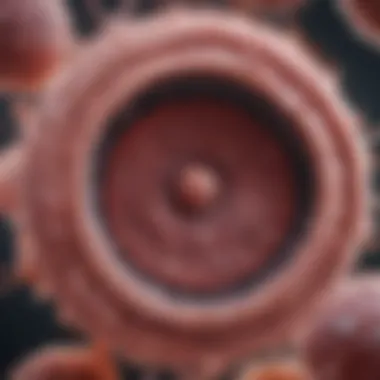Understanding Sessile Bladder Tumors: Diagnosis and Treatment


Intro
Sessile bladder tumors present a complex challenge in urological pathology. Understanding these tumors is essential for advancements in both diagnosis and treatment strategies. An exploration of their characteristics, treatment modalities, and implications for patient outcomes forms the foundation of contemporary urological practices. This article aims to provide a nuanced overview, catering to the needs of both academic and clinical audiences.
Background and Context
Overview of the Research Topic
The study of sessile bladder tumors is increasingly relevant in the field of urology. These tumors differ fundamentally from their pedunculated counterparts, exhibiting a flat morphology that complicates their detection and treatment. Accurate identification of sessile tumors is crucial for effective management, as they often harbor aggressive characteristics and a higher recurrence rate.
Historical Significance
Historically, the understanding of bladder tumors has evolved significantly. Early classifications often failed to recognize the diversity of tumor morphology. Over time, increased awareness and technological advancements have led to improved diagnostic capabilities, such as enhanced imaging techniques and more precise biopsy methods.
Understanding the characteristics of sessile bladder tumors has, therefore, allowed for a more targeted approach in treatment. Research has focused on developing methods to detect these tumors earlier, which has been shown to improve patient outcomes.
Key Findings and Discussion
Major Results of the Study
Recent studies highlight critical advances in the treatment of sessile bladder tumors. Key findings suggest that early intervention is linked to significantly improved patient survival rates. Furthermore, targeted therapies, including immune checkpoint inhibitors, show promise in managing these tumors effectively.
Detailed Analysis of Findings
The differentiation between various types of bladder tumors is essential. Sessile tumors, often classified as high-grade, may also demonstrate notable molecular abnormalities. These factors impact their biology and the treatment strategies employed. Effective scheduling of cystoscopic surveillance is vital for monitoring the disease progression.
In summary, a comprehensive understanding of sessile bladder tumors can inform better clinical practices and guide appropriate management strategies.
"Addressing sessile bladder tumors with a focused approach can lead to enhanced patient care and outcomes."
Moreover, the integration of multidisciplinary approaches in treatment planning reflects the complexity of managing bladder tumors. Engaging urologists, pathologists, and oncologists in collaborative care strategies fosters more effective patient management.
Understanding the implications of recent research enables healthcare professionals to adapt their practices accordingly, ensuring that patients receive the most efficacious treatments available. As research continues to advance, the potential for improving therapeutic outcomes remains high.
Understanding Sessile Bladder Tumors
Understanding sessile bladder tumors is essential for comprehending their implications on patient health and treatment pathways. These tumors, characterized by their flat and broad attachment to the bladder wall, present unique challenges in diagnosis and management compared to other tumor types. This section aims to provide clarity on their nature, the importance of distinguishing them from pedunculated tumors, and the epidemiological context surrounding these growths.
Definition of Sessile Bladder Tumors
Sessile bladder tumors are defined primarily by their non-stalked nature. Unlike pedunculated tumors, which are attached via a narrow stalk, sessile tumors arise directly from the bladder wall, presenting a flat profile. This morphological distinction is crucial in clinical settings as it affects both the diagnostic approach and surgical intervention strategies.
These tumors can range from benign to malignant, making it imperative for healthcare professionals to identify their nature accurately. Early identification and understanding of sessile tumors facilitate timely intervention, which can significantly impact patient outcomes.
"Recognition of sessile tumors directly correlates to the effectiveness of treatment regimens, highlighting their significance in urological health."
Contrast with Pedunculated Tumors
The contrast between sessile tumors and pedunculated tumors is critical in urology. Pedunculated tumors are often easier to excise surgically due to their stalk, allowing for straightforward access and removal. Conversely, sessile tumors pose challenges due to their larger surface area and intimate connection with the surrounding bladder tissue.
This difference influences the techniques employed in treatment. For instance, while transurethral resection may be appropriate for the latter, sessile tumors might require more extensive surgical strategies, such as partial cystectomy, especially if they are suspected to be malignant.
Understanding these differences enhances the clinical decision-making process.
Epidemiology
Epidemiologically, sessile bladder tumors are notable for their varied prevalence, which can depend on factors such as age, gender, and exposure to carcinogens. Research indicates that these tumors typically present in older adults, often correlating with a history of smoking or occupational hazards linked to chemical exposure. Bladder cancer, which includes both sessile and pedunculated tumors, is more prevalent in men than women, an observation that can guide screening recommendations.
In examining the epidemiological trends, it is notable that the incidence of bladder tumors has been rising globally, partially attributed to lifestyle factors and environmental influences.
Proper understanding of these epidemiological factors can inform future research directions and preventive strategies aimed at reducing the burden of bladder tumors.
Histological Characteristics
The histological characteristics of sessile bladder tumors are crucial in understanding their behavior, progression, and response to treatment. These characteristics provide insight into the cellular makeup of the tumor, its growth patterns, and the potential for malignancy. A thorough grasp of these features is essential for urologists and oncologists in both diagnostic and therapeutic contexts. Analyzing the histological properties aids in identifying the precise nature of the tumor, which can significantly influence treatment plans and prognostic expectations.
Cellular Composition
Sessile bladder tumors are comprised of various cell types that can indicate the tumor's origin and potential aggressiveness. The most common type of cell found in these tumors is transitional epithelium, but they may also contain different cellular components. Evaluating the cellular composition allows clinicians to recognize whether the tumor is benign or malignant.
- Transitional Cells: Found in most bladder tumors, these cells can change shape and are involved in the bladder's ability to expand.
- Muscle Cells: The presence of smooth muscle cells can indicate the degree of invasion and aggressiveness of the tumor.
- Fibroblasts: These cells contribute to the tumor's stroma and support.
Understanding the cellular makeup is key for determining the tumor's differentiation level, which can be linked to patient outcomes.
Morphological Features
The morphological features of sessile bladder tumors encompass the shape, architecture, and arrangement of the tumor cells. These features are vital for pathologists in diagnosing the tumor type and potential aggressiveness. For example, sessile tumors typically have a broad base and may appear infiltrative.
- Surface Irregularities: Tumors may present with varying degrees of surface irregularity, which can suggest different pathology.
- Infiltrative Growth Patterns: The ability of a tumor to infiltrate surrounding tissues can be a strong indicator of malignancy.
- Nuclear Characteristics: Changes in nuclear size and shape can signify abnormal growth and malignancy.


Evaluating these features is essential as they inform the likelihood of recurrence and metastasis.
Grading and Staging
Grading and staging are pivotal in assessing sessile bladder tumors. Grading reflects the tumor's aggressiveness based on histological examination, while staging describes the extent of the disease.
- Grading: This can range from low-grade tumors, which are less aggressive, to high-grade tumors that pose a significant threat. The World Health Organization provides a classification system for grading these tumors, which assists in predicting behavior.
- Staging: The staging process typically involves imaging studies alongside histological assessments. This helps in determining whether the tumor has invaded nearby tissues or metastasized to distant organs.
In summary, understanding the histological characteristics of sessile bladder tumors is imperative for developing effective treatment strategies. It serves as a foundation for diagnosis, influences prognosis, and aids in clinical decision-making. The intricate details found in these tumors underscore the importance of histopathological analysis in managing bladder cancer.
Clinical Presentation
Clinical presentation is a crucial aspect of understanding sessile bladder tumors. This section focuses on how these tumors manifest in patients, the relevance of identified symptoms, and the challenges in diagnosis. Accurate recognition of clinical features is essential for timely intervention, which can significantly affect patient outcomes.
Symptoms
Sessile bladder tumors may present with various symptoms, which often overlap with other urinary tract conditions. Common symptoms include:
- Hematuria: Blood in urine is the most prevalent symptom, and it can be either gross or microscopic. This symptom is often alarming for patients and usually prompts them to seek medical attention.
- Increased frequency of urination: Patients may find themselves needing to urinate more often than usual. This can occur even if the amount of urine produced is less than normal.
- Urgency: A sudden and compelling urge to urinate can occur, leading to discomfort and anxiety.
- Dysuria: Painful urination or burning sensation during urination can accompany these symptoms, indicating possible irritation or inflammation.
- Bladder pain: Some patients report discomfort or pain in the bladder area, especially during urination or when the bladder is full.
These symptoms can significantly impact a patient's quality of life. It is vital for healthcare providers to carefully assess these signs, as they can indicate the presence of sessile bladder tumors or other serious conditions.
Diagnostic Challenges
Diagnosing sessile bladder tumors can be complex due to several factors. First, the symptoms they produce are often non-specific, resembling those of more common benign conditions, such as urinary tract infections or bladder inflammation. This can lead to delays in diagnosis.
Additionally, imaging techniques, while helpful, may not always clearly differentiate between malignant and benign lesions. Techniques such as ultrasound, CT scans, and MRIs can visualize bladder abnormalities but may miss subtle signs indicative of sessile tumors.
Moreover, the placement of these tumors close to the bladder wall complicates their detection. Conventional cystoscopy is a reliable method for identifying bladder malignancies, but technical limitations exist, particularly if the tumor is small or flat.
To summarize:
- Challenge in symptom identification: Symptoms often mimic those of other conditions.
- Dependence on imaging assessments: Imaging doesn’t always provide definitive answers.
- Role of cystoscopy: While useful, cystoscopy has limitations that can affect early detection.
"A careful clinical assessment combined with advanced imaging and a thorough cystoscopic evaluation is crucial for accurate diagnosis of sessile bladder tumors."
Recognizing these diagnostic challenges is vital for healthcare professionals, as an informed approach can lead to better management strategies for patients presenting with suspicious symptoms.
Diagnosis of Sessile Bladder Tumors
Diagnosing sessile bladder tumors is essential for effective patient management and treatment planning. Early detection can significantly affect the prognosis and therapeutic approaches. Therefore, understanding the various diagnostic modalities and their applications is critical.
Different diagnostic methods contribute uniquely to the identification and evaluation of these tumors, allowing healthcare providers to make informed decisions. The choice of diagnostic techniques often depends on the clinical scenario and available resources.
Imaging Techniques
Imaging techniques play crucial roles in visualizing bladder tumors. They assist in understanding tumor size, location, and any surrounding tissue involvement. Three primary imaging modalities are used:
Ultrasound
Ultrasound is a non-invasive imaging technique widely used for evaluating bladder tumors. Its key characteristic is the ability to provide real-time images of the bladder and surrounding structures. The benefit of ultrasound lies in its accessibility and cost-effectiveness.
One unique feature of this method is that it requires no ionizing radiation. However, ultrasound is limited in characterizing the tissue quality of the tumor. While it can identify masses, further imaging is often necessary for a comprehensive evaluation.
CT Scans
CT scans offer detailed cross-sectional images of the bladder and are invaluable for assessing tumor extent. The high-resolution images produced by CT scans make it a popular choice for staging bladder cancer.
A unique feature of CT is its capacity to detect not only tumors but also lymph node involvement and metastasis. Nevertheless, CT scans expose patients to ionizing radiation, which poses a risk with repeated studies. Overall, CT scans provide critical information for treatment planning but must be used judiciously.
MRI
MRI is another advanced imaging technique used in the diagnosis of bladder tumors. Its key characteristic is the superior soft tissue contrast it offers. This allows for precise imaging of the bladder wall and surrounding tissues.
A unique benefit of MRI is its ability to differentiate between benign and malignant tissues more effectively than other imaging modalities. However, MRI can be more costly and less accessible than other imaging methods, which may limit its use in certain scenarios.
Cystoscopy
Cystoscopy is a fundamental diagnostic procedure that involves the direct visualization of the bladder interior. This technique allows for a detailed examination of bladder mucosa. During cystoscopy, healthcare providers can obtain biopsy samples if tumor presence is suspected. It plays an important role although it can cause some discomfort during the procedure.
Biopsy Procedures
Biopsy procedures are critical for confirming the diagnosis of sessile bladder tumors. This invasive technique allows for histological examination of tissue samples. Transurethral resection is one common method that not only serves diagnostic purposes but can also provide therapeutic benefits by removing tumor tissue. Biopsies should ideally be performed during cystoscopy to ensure precise targeting of suspicious areas. Ultimately, obtaining a clear and accurate diagnosis using these methods is essential for informing treatment and improving patient outcomes.
Treatment Options
Treatment options for sessile bladder tumors hold significant importance in managing patient outcomes and quality of life. These options are not only about removing tumors but also involve a comprehensive strategy that addresses the tumor's characteristics, the patient's health status, and potential for recurrence. As bladder tumors exhibit varied behavior, a tailored approach to treatment can enhance efficacy, minimize complications, and improve overall survival rates.
Surgical Interventions
In the domain of bladder tumor management, surgical interventions are often the cornerstone of treatment. Among these, Transurethral resection and Radical cystectomy stand out as the primary options.


Transurethral Resection
Transurethral resection, commonly referred to as TUR, is a minimally invasive procedure. This method involves the removal of the tumor using a resectoscope inserted through the urethra. TUR is beneficial because it preserves the bladder's structure and function, which is vital for maintaining urinary capacity.
A key characteristic of TUR is its ability to allow for immediate visualization and resection, which can be particularly effective for localized sessile tumors. The procedure usually results in shorter recovery times compared to radical approaches, making it a popular choice for many urologists.
However, this option does have its limitations. While TUR is effective for superficial tumors, it may not be adequate for deeper lesions or cases where there is a high risk of recurrence. Therefore, follow-up procedures may be necessary to ensure complete removal and monitoring of potential regrowth.
Radical Cystectomy
Radical cystectomy involves the complete removal of the bladder and surrounding tissues. It is often recommended for patients where the tumor has invaded muscular layers or when superficial treatments fail. This procedure is crucial for preventing the spread of cancer and is considered a more definitive treatment for high-risk tumors.
A critical advantage of radical cystectomy is that it allows for the complete excision of malignant tissues, thereby reducing the likelihood of recurrence. However, it comes with the trade-off of significant implications for a patient’s lifestyle, as it typically necessitates urinary diversion.
The decision to pursue radical cystectomy must consider the patient’s overall health, cancer stage, and personal preferences, given potential complications like incontinence and changes in sexual function.
Adjuvant Therapies
Following surgery, adjuvant therapies play a key role in enhancing treatment outcomes. These therapies, such as chemotherapy and immunotherapy, aim to address residual disease and reduce recurrence rates.
Chemotherapy
Chemotherapy involves the use of cytotoxic drugs to eliminate cancer cells, particularly in cases that are aggressive or likely to recur. In the context of bladder tumors, chemotherapy often follows surgical intervention and can be administered systemically or intravesically. It has proven effective in not only shrinking the tumors but also in prolonging survival rates.
A notable aspect of chemotherapy is its ability to tackle microscopic disease that may not be detectable. Programs employing chemotherapy are beneficial for promoting better responses in patients at high risk for metastasis.
However, chemotherapy is not without drawbacks. Side effects can range from fatigue and nausea to more serious conditions like neutropenia. Monitoring during treatment is critical to managing these adverse effects and ensuring patient safety.
Immunotherapy
Immunotherapy represents a newer frontier in bladder cancer treatment, leveraging the patient’s immune system to target cancer cells. Treatments such as atezolizumab or nivolumab have shown promise, particularly in patients with advanced disease. These therapies are often recommended for patients who have not responded well to traditional options.
A key benefit of immunotherapy is its relatively mild side effect profile compared to conventional chemotherapy and its success in activating a sustainable immune response against tumors. However, the uniqueness of each patient’s immune response can lead to variable outcomes, making it essential to monitor efficacy and tolerability closely.
Emerging Treatment Modalities
As research progresses, emerging treatment modalities for bladder tumors provide new hope and improving outcomes. These include experimental therapies and personalized treatment strategies based on the genetic makeup of tumors. This area is rapidly evolving, offering possibilities for targeting treatments more effectively.
The above segments highlight the diverse range of treatment options available for sessile bladder tumors. The complexity of tumor biology and individual patient circumstances necessitates a tailored approach that promotes effective management strategies.
Prognosis and Outcomes
Understanding the prognosis and outcomes of sessile bladder tumors is essential for both the patients and healthcare providers. Prognosis encompasses a range of factors, mainly focused on survival rates and the chance of recurrence after treatment. This section aims to equip readers with insights into the survival statistics associated with sessile tumors, as well as the various elements that influence these outcomes.
Survival Rates
Survival rates for sessile bladder tumors can vary significantly based on several factors, including tumor stage and grade at the time of diagnosis. Generally, early-stage sessile tumors have considerably better outcomes compared to those diagnosed at more advanced stages. According to various studies, the five-year survival rate for patients with superficial bladder cancer can be around 70% to 80%, whereas for invasive cases, this figure drops dramatically.
Several studies indicate the following key statistics:
- Tumors detected at stage 0 may have a survival rate exceeding 90%.
- At stage I, the rate can decrease to about 80%.
- For stage II, survival rates approximate 50%.
- Advanced stages (stage III and IV) typically see rates drop to beneath 30%.
The specific numbers will vary widely among studies due to differences in sample sizes and methods. However, these figures underscore the importance of early detection and intervention.
"Early diagnosis is crucial for improving survival outcomes in patients with sessile bladder tumors."
Factors Affecting Prognosis
Various factors can influence the prognosis of patients with sessile bladder tumors. Understanding these elements is critical for tailoring individualized treatment plans and improving outcomes. Some of the key factors include:
- Tumor Stage: As noted earlier, the stage of the tumor at diagnosis significantly impacts survival rates. The extent of invasion into the bladder wall is crucial.
- Tumor Grade: Higher-grade tumors tend to have more aggressive behavior and a poorer prognosis.
- Patient Health: Comorbid conditions, age, and overall health play a role in treatment response and survival.
- Response to Treatment: The effectiveness of initial treatments, be it surgical or adjuvant therapies, affects long-term outcomes.
- Recurrence Risk: Sessile tumors are known to have a higher risk of recurrence compared to pedunculated types. Monitoring for recurrence is essential after treatment.
Improving prognosis requires continuous research and attention to these factors that influence patient outcomes. The knowledge gained from understanding prognosis can guide therapy to enhance the quality of life for those affected.
Recent Advances in Research
Recent advances in research surrounding sessile bladder tumors are vital in enhancing our understanding of these complex conditions. As the medical community continues to investigate the molecular and genetic underpinnings of these tumors, clinicians can better tailor treatment options to individual patients. Furthermore, understanding the biological mechanisms at play allows for the development of novel therapeutic strategies that may significantly improve patient outcomes.
In this section, we explore two important facets of recent research: genetic insights and clinical trials. Each of these has transformative potential in the landscape of bladder cancer treatment and management.
Genetic Insights
Genetic insights are reshaping our approach to sessile bladder tumors. Increasingly, researchers are identifying specific genetic mutations and alterations that predispose individuals to bladder cancer. For instance, mutations in the FGFR3 and TP53 genes have been linked significantly to tumor development and prognosis. Identifying these mutations can assist in risk stratification, helping clinicians predict disease progression.
Moreover, advancements in genomic technologies, including next-generation sequencing, allow for a more comprehensive analysis of tumor genomes. This information can guide personalized treatment strategies. By understanding the genetic profile of a patient’s tumor, oncologists may select therapies that target specific pathways involved in tumor growth.
"The integration of genetic biomarkers has the potential to revolutionize personalized treatment protocols for bladder tumors, enhancing overall patient care."
Furthermore, research into epigenetics takes center stage. Epigenetic modifications, which are heritable changes affecting gene expression without altering the DNA sequence, play a significant role in tumor development. By understanding how these modifications influence tumor behavior, new therapeutic targets may emerge.
Clinical Trials and Innovations


Clinical trials are a cornerstone of medical advancement, and for sessile bladder tumors, numerous innovative studies are underway. These trials not only test existing therapies but also explore new agents, including novel immunotherapeutic approaches. Immunotherapy leverages the body’s immune system against cancer cells, showing promise in treating advanced bladder cancer forms.
Additionally, multi-center studies aim to evaluate combination therapies. These therapies might integrate immunotherapy with chemotherapy or targeted agents to enhance therapeutic efficacy. Preliminary results from these studies indicate that combining these modalities can lead to improved survival rates compared to traditional treatments alone.
Moreover, enhanced drug delivery systems are being explored. For example, localized delivery methods to target bladder tumors directly may reduce systemic side effects while maximizing treatment impact.
In summary, recent advances in genetic research and ongoing clinical trials represent a proactive stance in the fight against sessile bladder tumors. By continuing to follow these exciting developments, healthcare professionals can contribute to creating more effective treatment paradigms, improving the quality of life for patients.
Quality of Life Considerations
Quality of life (QOL) is a crucial aspect when discussing any medical condition, especially in the context of sessile bladder tumors. These tumors, being a form of bladder neoplasm, can significantly impact both the physical and psychological well-being of patients. Understanding these effects is essential for both healthcare providers and patients alike.
When a patient receives a diagnosis of a sessile bladder tumor, the initial impact can be overwhelming. The very nature of this diagnosis often brings forth feelings of anxiety and stress. Patients may worry about the implications of the tumor, treatment options, and their future health outcomes. Studies indicate that emotional support and effective communication from healthcare professionals can alleviate some of these concerns, fostering a more robust coping mechanism.
Changes in bodily functions, such as urination patterns and bladder control, are another critical factor affecting QOL. Patients may experience frequent urination, pain, or discomfort, which can disrupt their daily activities. Such challenges may lead to social withdrawal and reduced engagement in activities previously enjoyed.
Furthermore, the treatment process can introduce additional burdens. Surgical interventions, such as a transurethral resection or radical cystectomy, can lead to recovery periods that are physically taxing. Pain management and rehabilitation become important considerations in the context of maintaining QOL during this phase. Moreover, the possibility of complications arising from treatments, such as incontinence or changes in sexual function, emphasizes the importance of a well-rounded approach to patient care.
The biopsychosocial model of health recognizes that a patient's environment and emotional state are integral to their overall well-being. As such, addressing the psychological and social aspects alongside the physical ones is vital. Support groups, counseling, and educational resources can empower patients, helping them to navigate the complexities of their condition with a better understanding.
In summary, the considerations of quality of life in patients diagnosed with sessile bladder tumors must not be overlooked. By recognizing the multifaceted challenges they face, healthcare providers can develop a more comprehensive care plan, promoting an enhanced overall experience for the patient.
Impact of Diagnosis
The diagnosis of a sessile bladder tumor holds substantial significance for patients and their caregivers. Receiving a cancer diagnosis can be a critical turning point that alters one's perspective on health and well-being. Patients may experience a wide range of emotions, from disbelief to fear, as they process what this diagnosis means. The initial shock can lead to a sense of vulnerability, leaving them feeling uncertain about their future.
One of the most immediate impacts is the need for increased medical attention. Patients may find themselves navigating a complex healthcare system, coordinating various appointments for specialists, imaging, and treatments. Each step in the process can be daunting, creating a feeling of being overwhelmed. In addition, patients could experience financial concerns, as treatment options may carry significant costs.
It's essential to communicate openly with healthcare providers during this process. Having clear and accurate information enables patients to understand their condition better, which can lead to a more proactive approach in managing their healthcare. This empowerment can help mitigate feelings of helplessness often associated with a cancer diagnosis.
Post-treatment Care
Post-treatment care is a vital component in supporting patients who have undergone treatments for sessile bladder tumors. The focus during this phase often shifts to recovery and monitoring for any signs of recurrence. Effective follow-up care becomes critical to ensure that patients receive the necessary support as they transition from treatment to daily life.
Once treatment is complete, patients may face various challenges, including fatigue, potential complications, or emotional distress related to their experience. Having a structured post-treatment care plan can aid in effectively managing these issues. This may involve regular check-ups, surveillance tests, and symptom management strategies tailored to individual needs.
Healthcare providers play a pivotal role in delivering this care. Educating patients about what to expect in the post-treatment phase can help in reducing anxiety and uncertainty. Support services, including nutritional counseling and physical therapy, can also help in regaining strength and promoting overall health.
Furthermore, mental health support cannot be understated during this time. Patients may experience feelings of isolation or depression as they adapt to life after cancer treatment. Access to counseling or support groups can provide a valuable outlet for their emotions and foster connections with others who understand their experiences.
Future Directions in Bladder Tumor Research
Understanding the future directions in bladder tumor research is essential for improving treatment outcomes and enhancing patient quality of life. This area of study not only focuses on refining existing methodologies but also looks at innovative strategies that can bring about significant advances in how sessile bladder tumors are managed. As we delve into this topic, we see that the emphasis on personalized medicine and integrative therapeutic strategies can lead to a more tailored approach to patient care, ultimately benefiting a diverse range of individuals affected by this condition.
Personalized Medicine Approaches
Personalized medicine is a transformative concept in cancer treatment. It emphasizes tailoring medical treatment based on individual patient characteristics including genetic, biomarker, and phenotypic profiles. In the context of sessile bladder tumors, this means that treatments may be adapted to suit not just the tumor characteristics, but also the broader biological and genetic context of the patient.
This approach could revolutionize treatment by:
- Enhancing Targeted Therapies: By using genomic sequencing, researchers can identify mutations specific to an individual’s tumor. This allows for the development of targeted therapies, improving effectiveness while reducing side effects.
- Predicting Treatment Response: Understanding which patients will respond to specific therapies can optimize treatment plans, potentially avoiding ineffective treatments that consume valuable time and resources.
Moreover, integrating data from various sources—including clinical trials, genetic mapping, and real-world evidence—strengthens the case for personalized approaches. As research progresses, the hope is that we can shift from a one-size-fits-all model to a more nuanced understanding of bladder tumors.
Integrative Therapeutic Strategies
Integrative therapeutic strategies bring together different treatment modalities to address bladder tumors comprehensively. This multifaceted approach acknowledges that no single treatment exists that can effectively combat every aspect of a tumor. By combining surgical, medical, and supportive therapies, we can enhance treatment effectiveness.
Consider the following points:
- Surgical Interventions and Adjunct Therapies: While surgical removal of tumors remains crucial, integrating therapies such as chemotherapy and immunotherapy can address residual tumor cells and increase the likelihood of successful outcomes.
- Holistic Patient Care: Incorporating psychological support and rehabilitation into the treatment plan can improve the overall well-being of patients. Factors such as mental health, nutrition, and physical fitness should not be overlooked in the cancer journey.
Emerging Research: The exploration of combining different therapies is ongoing. For instance, studies examining the synergy between immunotherapy and targeted therapies demonstrate promise, suggesting that a blend can effectively elicit immune responses against tumors while also addressing specific tumor characteristics.
"Integrative strategies can not only improve survival outcomes but also enhance the quality of life for patients battling sessile bladder tumors."
As we look ahead, combining personalized medicine approaches with integrative strategies offers immense potential for advancing the landscape of bladder cancer treatment. Such strategies are paramount in the effort to foster a more effective therapeutic environment that is thoughtful and patient-centered.
Ending
The conclusion of this article serves as a meaningful reflection on the comprehensive examination of sessile bladder tumors. By synthesizing the information presented throughout, we reiterate the importance of understanding these tumors in the context of bladder pathology. This article highlights critical aspects such as their unique histological characteristics, clinical presentations, and the various diagnostic and treatment options available. Each of these elements plays a significant role in shaping patient outcomes.
In summary, recognizing the nuances of sessile bladder tumors allows for more tailored approaches in treatment. It empowers healthcare providers with knowledge to make informed decisions that can enhance patient quality of life. Furthermore, this understanding encourages proactive screening and early intervention, which are vital in managing these tumors effectively.
The benefits of comprehensively understanding sessile bladder tumors extend beyond individual patient care. It contributes to the broader field of urological research. As advancements continue to unfold, a well-rounded grasp of bladder tumor pathology will enable clinicians and researchers to explore innovative therapies and refining existing treatment protocols. This is not just a medical necessity but a responsibility that we owe to our patients and the future of urological health.
Summary of Key Points
- Definition and Nature: Sessile bladder tumors are distinct in their growth pattern, differing significantly from pedunculated tumors.
- Epidemiology: Insights into the prevalence and demographic implications highlight the necessity for awareness among healthcare professionals.
- Diagnosis and Challenges: Various imaging techniques and cystoscopy are paramount in effective diagnosis, albeit with certain challenges.
- Treatment Approaches: A spectrum of treatment options exists, ranging from surgical interventions like transurethral resection to adjuvant therapies.
- Ongoing Research: There is a continuous need for research in better understanding the genetic aspects and exploring clinical trials to innovate treatment modalities.
Call to Continued Research
The ongoing quest for knowledge in the realm of bladder tumors, particularly sessile tumors, is vital. Current research efforts must focus on the following:
- Personalized Medicine: As treatments evolve, there’s a growing emphasis on tailoring therapies to individual genetic profiles. This will likely enhance efficacy and minimize side effects.
- Clinical Trials: Participation in clinical trials remains essential for discovering new treatments and optimizing existing modalities. These trials can lead to breakthroughs in how sessile bladder tumors are managed.
- Innovative Therapeutics: Exploration of integrative approaches that combine multiple therapeutic strategies may also yield better outcomes.
Continued investment in research on sessile bladder tumors is not just a scientific pursuit; it’s critical for advancing patient care and survival outcomes.







